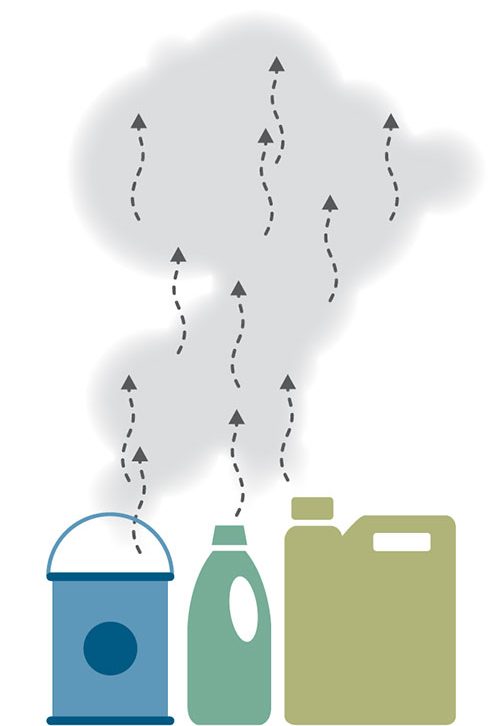Investigating Vapor Intrusion
Vapor intrusion is a way that volatile chemicals (see text box) in soil and groundwater can enter and build up inside buildings. When chemicals spill or leak into the ground, they can contaminate the soil and the groundwater. Depending on the type and amount, these chemical vapors can possibly affect your health if you breathe them in indoor air.1
If scientists suspect that people are being exposed to chemicals through vapor intrusion, they may conduct a vapor intrusion investigation.
If scientists suspect vapor intrusion in a community, they first gather information about the type, amount, and location
of contamination in soil, groundwater, and indoor air. If this information shows that vapor intrusion is a concern, scientists collect additional samples to confirm it.
- Scientists collect samples from indoor air, from beneath the building (sub-slab gas samples), and sometimes from
outdoor air as well. Samples are usually collected from people’s homes over a 24 hour period. - If weather can affect the test results, scientists may collect samples during different times of the year.
- Scientists then send the air samples to a laboratory where they are tested for various chemicals. The results will then be shared with the occupants and/or owners of each home.
- Many of the chemicals found in vapor intrusion investigations are also found in common household products such as paints, air fresheners, and cleaning supplies.
- To focus on just the chemicals that may be coming from vapor intrusion, scientists may identify household products containing chemicals and remove them (whenever possible) before collecting indoor air samples.
Volatile chemicals are a class of chemicals that are volatile (evaporate easily) and form a vapor in the air. Some common volatile chemicals include the dry cleaning chemical tetrachloroethylene and benzene which is a component of automotive gasoline.
Chemicals detected during a sampling event that are not entirely the result of underground contamination are referred to as “background contamination.”

You can take these steps to help improve your home’s indoor air quality:
- Get more fresh air into your home. Ventilation can
keep any volatile chemicals in your home from
building up to unsafe levels.2
- Open windows and use fans to bring in fresh air
directly – unless you have asthma triggered by
outdoor air pollution or pollen in your area. - If your ventilation, heating, and air conditioning
systems have filters, you may be able to adjust
the fresh-air intake to increase air exchange while
removing pollen, dust, or other asthma irritants
brought in from outdoors. - Seal cracks or holes in the floor or foundation to
keep any volatile chemicals under your home from
coming in. - Use and store fewer products that contain volatile
chemicals (such as fuels, certain paints, paint
thinners, and products that remove glue and
adhesives).- When you use such products, follow the product recommendations carefully.
- Open windows and run a fan to reduce the amount of the chemical in indoor air.
- Avoid smoking tobacco products indoors.
- If scientists find that vapor intrusion could harm your health, they may install a mitigation system to keep volatile chemicals from entering your home.3 Mitigation systems are usually made up of a fan and a system of pipes that draw the soil gases from beneath your home and release them outside so they can scatter and break down naturally.
- Scientists may recommend adjusting heating, ventilation and air conditioning systems in larger commercial buildings to regulate indoor air pressure and keep vapors from being pulled inside.
- Sealing openings and installing a vapor barrier (made of plastic sheeting) may also reduce vapor intrusion.
- Vapor intrusion website, visit: https://www.epa.gov/vaporintrusion
- Vapor intrusion website, visit: https://itrcweb.org/teams/projects/vapor-intrusion
- Vapor intrusion fact sheet, visit: https://www.atsdr.cdc.gov/vapor-intrusion.html
1 ATSDR’s Toxic Substances Portal provides information about chemical health effects and is located at https://wwwn.cdc.gov/TSP/index.aspx.
2 Unless a significant source of outdoor air contamination has been identified.
3 For more detailed information, see US EPA’s Engineering Issue: Indoor Air Vapor Intrusion Mitigation Approaches https://clu-in.org/download/char/600r08115.pdf.
